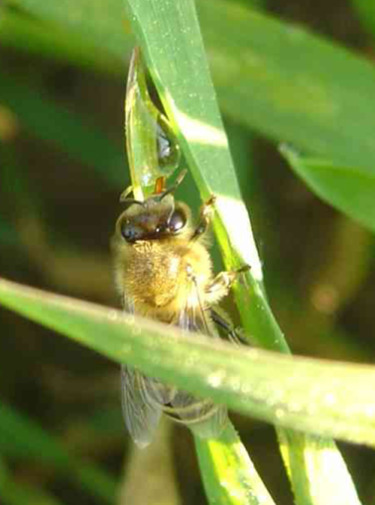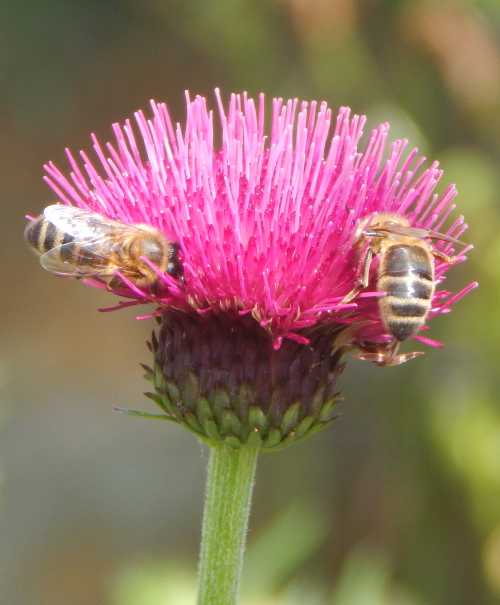Bees, Guttation And Neonicotinoids:
This page concerns the UK government body, FERA and in particular their response to a study by Girolami et al.
FERA vs Girolami et al on toxic guttation and bees
In a report, FERA (the UK government Food and Environment Research Agency) examined the issue of 'guttation'.
This was following the release of an independent paper by Girolami et al.
There was also an experiment conducted by a group of German Beekeepers.
Having read the report, and the Girolami study along with others, it is my opinion that Fera's assessment of the issue and the Girolami study is misleading, and in particular, in my view uses flawed studies to deliberately cast doubt over Girolami's independent, peer reviewed work.
In it
their analysis in relation to guttation and in particular, the Girolami study,
FERA state:
“Only one
study (Girolami et al 2009) has shown a significant effect in honeybees but
this should be treated with caution as the data were generated by feeding
collected droplets directly to bees and in many cases sucrose was added to
ensure the honeybees consumed the dose.”
This is
misleading, because it is made to sound that the
addition of sucrose to all of the guttation fluid combined with the direct
feeding to bees, is reason to be suspicious of Girolami’s study – almost
giving the impression the bees are deliberately tricked into consuming
pesticide.
In actual fact, Girolami added sucrose to only some of the samples, and other bees were fed
plain guttation drops. This made no
difference to the toxic effects - this significant point is not
mentioned.
 Honey bee consuming guttation drop - photograph taken 'in the field'.
Honey bee consuming guttation drop - photograph taken 'in the field'.In addition to which, and following on from the point above, in
regulatory tests for oral toxicity, the 'test pesticides' are mixed with a
sucrose solution anyway!
FERA know this, and they know all about regulatory test
methodologies and indeed, Helen Thompson of FERA certainly knows this –
she conducted the oral toxicity tests on behalf of Bayer CropScience to
support the DAR for imidacloprid.
In these test, Helen Thompson fed bees test
solution mixed with sucrose, as described, via feeders.
However, Girolami, was, I believe,
more robust in his scientific methods than the regulatory EPPO guidelines demand.
He discarded
bees that did not drink the substance – thus 100% of the test groups had
definitely consumed the neonicotinoid being tested.
With regulatory tests, the bees get to ‘share among themselves’ the test substance.
In other words, for all we know, in regulatory tests, some bees may have
taken the substance, some may not (take into account there may be any
number of reasons for this, for example, they are anaesthetised
first).
Here is an analogy:
Imagine a pharmaceutical drug being tested on humans, who were in a ward
and having gained consciousness again following anaesthetic, they can then
(voluntarily) help themselves to a drink (or not) from a dispenser (which
happens to contain the medicine).
If the same principles were in action for regulating human medicines that are in place for insecticides, then if just one person died, this would
this give the pharmaceutical company the right to claim that in the regulatory trial, only 1 person out of 10 had actually died from taking the medicine.
However, this neglects a very crucial question: how many of those 10 people actually took the medicine in this 'voluntary' situation? If only one person took it - the one who died, suddenly the regulatory test does not look so reassuring. Would you want to take a medicine that ad been tested using such methodology?
The point being, that unless we know for sure
all 10 of the patients definitely took the medicine, it would not be correct
for a pharmaceutical company to state 'no negative effects in 90% of
cases'.
This is why I believe Girolami's methodolgy is more robust, whereas the regulatory methodology is a farce.
- FERA then went on in their report to use a flawed Swiss
study to cast doubt on Girolami's paper, along with a study by Shawkti, that
didn’t even use systemic pesticides.
- You can read more about this and other issueson my page about field tests for pesticides.
If you found this page helpful or interesting, I'd really be grateful if you would share it with others - if not this page, perhaps another, such as Gardening For Bees.
Thank you so much :) .
